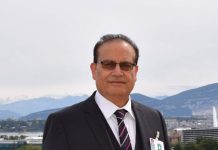Dr. Muhammad Akram Zaheer
A new group of leaders in Iran is coming up and they are stricterin their beliefs than those who have been in charge for the past 45 years. This change is happening because the government wants to stay in control, especially since many people in the country are losing faith in the system that has been run by religious leaders for a long time. In the 2024 elections, there is a big internal power struggle happening as the country prepares for a new top leader.
The elections on March 1 had the lowest voter turnout since the government was established in 1979. Only about 40% of eligible voters participated and some reports say it might be even lower. Key figures, like the speaker of the outgoing parliament, Mohammad Bagher Ghalibaf, did not do well in the elections. In Tehran, the capital, only 25% of people voted. In the Assembly of Experts, which is a group that helps choose the top leader, Sadegh Larijani lost his position.
Even former President Hassan Rouhani could not run for the Assembly of Experts. This manipulation of the elections has been going on since 2004, when the Guardian Council, a group that approves candidates, disqualified many reformists. Instead of solving political issues, this move made things worse over the next 20 years, leading to conflicts between different conservative groups. The struggle between more practical thinkers and strict ideologues continued during the presidencies of Mahmoud Ahmadinejad and Hassan Rouhani, who both served two terms from 2005 to 2021.
Supreme Leader Ayatollah Ali Khamenei has been mediating between different groups trying to gain power and influence for a long time. In the past 20 years, this process, usually done in private, increasingly needed his direct involvement and became more public. This was most noticeable during the Ahmedinejad era (2005-13) when the then-president not only clashed with fellow conservatives but also opposed Khamenei in his second term.
This made divisions among conservatives more pronounced, especially when the U.S. imposed more sanctions. To address this, Khamenei allowed the return of pragmatic conservative forces. In the 2013 elections, Rouhani, a pragmatic conservative, won decisively. This move helped Khamenei in two ways. First, it restored public support for the regime, which had suffered from the controversial 2009 elections and the subsequent uprising. Second, it created room for Tehran to negotiate a nuclear agreement with the U.S. amid severe sanctions.
Despite serious financial difficulties and the need for domestic stability, talks with the U.S. caused divisions in the Iranian political establishment. Rouhani’s pragmatic approach clashed with the more ideologically driven clerics and the IRGC. The 2015 nuclear deal was a win for the pragmatists, but it didn’t last. The Trump administration’s 2018 decision to withdraw from the deal and reinstate sanctions undermined Iran’s pragmatic conservatives.
In response, Iran retaliated, leading to the U.S. killing Qassem Soleimani in early 2020, further strengthening the ideologues and weakening the pragmatic conservatives, who had already lost ground during Rouhani’s second term (2017-21). Before the 2021 presidential elections in Iran, the Guardian Council limited the candidates to ensure Ebrahim Raisi, a strict and influential figure, would win. This move also weakened the power of others, like Ali Larijani, who was disqualified despite attempts to reverse the decision. Over the years, Supreme Leader Khamenei’s influence declined and the IRGC-led security establishment gained strength. Raisi’s presidency marked a shift to a more conservative government.
To solidify control, especially after protests due to economic hardships, Raisi’s administration enforced stricter public restrictions, especially for women’s dress codes. This led to the death of Mahsa Amini in 2022, triggering widespread protests that lasted almost a year. The government faced criticism from within, with senior figures expressing concerns about the regime’s stability. Khamenei had to defend the government’s actions and there were promises to revise laws related to women’s dress codes, although no concrete actions followed.
The protests eventually subsided in mid-2023. Amidst public discontent, economic challenges, and internal power struggles, the upcoming elections were crucial. Ideologues aimed to secure a majority in the parliament and the Assembly of Experts, which plays a role in choosing the next supreme leader. While ideologues controlled the Guardian Council, runoffs for parliamentary seats were expected and the Assembly’s composition remained uncertain. With widespread dissatisfaction, economic issues and power struggles among elites, the future of the Iranian regime might hinge on the armed forces which are not immune to public sentiments.

















